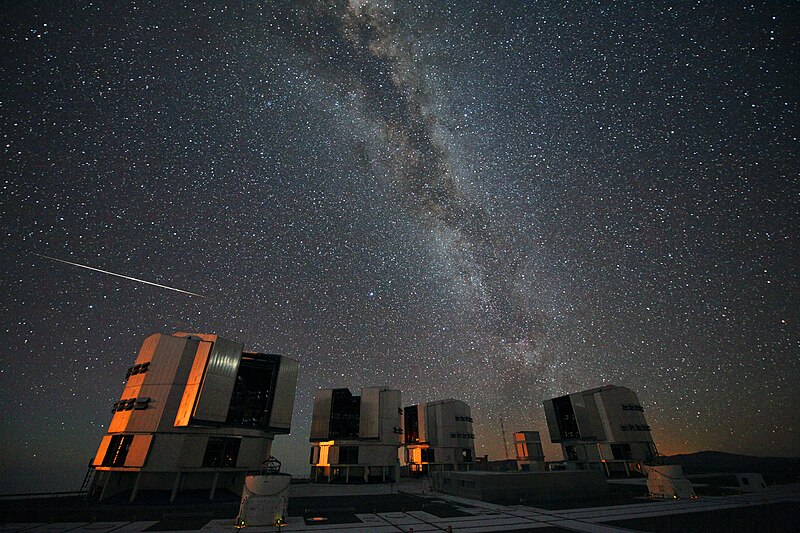Ficheiro:The 2010 Perseids over the VLT.jpg

Tamaño desta vista previa: 800 × 533 píxeles. Outras resolucións: 320 × 213 píxeles | 640 × 427 píxeles | 1.024 × 683 píxeles | 1.280 × 853 píxeles | 2.560 × 1.707 píxeles | 5.616 × 3.744 píxeles.
Ficheiro orixinal (5.616 × 3.744 píxeles; tamaño do ficheiro: 5,68 MB; tipo MIME: image/jpeg)
Historial do ficheiro
Prema nunha data/hora para ver o ficheiro tal e como estaba nese momento.
| Data/Hora | Miniatura | Dimensións | Usuario | Comentario | |
|---|---|---|---|---|---|
| actual | 19 de febreiro de 2024 ás 17:32 |  | 5.616 × 3.744 (5,68 MB) | C messier | full size |
| 18 de agosto de 2010 ás 09:34 |  | 4.000 × 2.667 (5,82 MB) | Lars Lindberg Christensen | {{Information |Description={{en|1=Every year in mid-August the Perseid meteor shower has its peak. Meteors, colloquially known as “shooting stars”, are caused by pieces of cosmic debris entering Earth’s atmosphere at high velocity, leaving a trail o |
Uso do ficheiro
A seguinte páxina usa este ficheiro:
Uso global do ficheiro
Os seguintes wikis empregan esta imaxe:
- Uso en af.wikipedia.org
- Uso en ar.wikipedia.org
- Uso en en.wikipedia.org
- Uso en eo.wikipedia.org
- Uso en es.wikipedia.org
- Uso en fa.wikipedia.org
- Uso en he.wikipedia.org
- Uso en hr.wikipedia.org
- Uso en hu.wikipedia.org
- Uso en it.wikipedia.org
- Uso en la.wikipedia.org
- Uso en mk.wikipedia.org
- Uso en ml.wikipedia.org
- Uso en ms.wikipedia.org
- Uso en my.wikipedia.org
- Uso en nn.wikipedia.org
- Uso en pl.wikipedia.org
- Perseidy
- Portal:Astronomia/Artykuł miesiąca 08 2012
- Portal:Astronomia/Artykuł miesiąca 08 2013
- Portal:Astronomia/Artykuł miesiąca 08 2014
- Portal:Astronomia/Artykuł miesiąca 08 2015
- Portal:Astronomia/Artykuł miesiąca 08 2016
- Portal:Astronomia/Artykuł miesiąca 08 2017
- Portal:Astronomia/Artykuł miesiąca 08 2018
- Portal:Astronomia/Artykuł miesiąca 08 2019
- Portal:Astronomia/Artykuł miesiąca 08 2020
- Portal:Astronomia/Artykuł miesiąca 08 2021
- Portal:Astronomia/Artykuł miesiąca 08 2022
- Uso en ro.wikipedia.org
- Uso en sh.wikipedia.org
- Uso en sk.wikipedia.org
- Uso en sl.wikipedia.org
- Uso en sv.wikipedia.org
- Uso en tr.wikipedia.org
- Uso en vi.wikipedia.org
- Uso en www.wikidata.org
- Uso en zh.wikipedia.org
